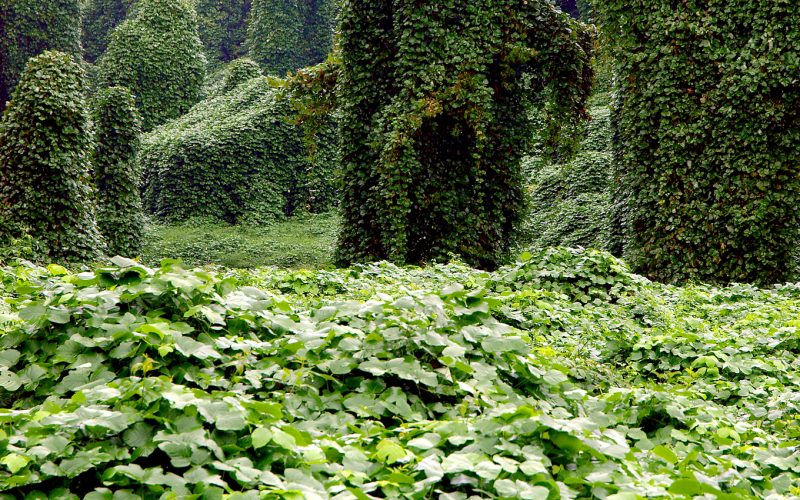
Courtesy Photo
Kudzu is an invasive species that grows wildy over areas. Virginia Creeper is a native alternative.
Many articles write about what not to plant (invasive non-natives that range in skill from killing bald eagles to increasing tick-borne illness). But what, then, should be planted instead? Luckily there are local nurseries, organizations, and extensive easy-to-use educational resources available to get us planting that which does not require an army of future generations to remove it.
Whether you need ground cover, grasses, shrubs, trees, vines, hedges, flowers or pest deterrents, natives can provide practical benefits and aesthetic value. An alternative to the much-loved Asian Wisteria is American Wisteria, a woody-stemmed lookalike vine that is great for arbors and very showy. Other alternatives to invasive vines include Trumpet creeper (Campsis radicans) and Coral honeysuckle (Lonicera sempervirens).
Most of us love pandas but we don’t need to plant non-native Bamboo. River Cane (Arundinaria gigantea) is a native that looks very similar and does not overtake ecosystems. It still provides an attractive privacy screen or fence.
Ground cover is important to reduce erosion, but planting the purple periwinkle is not necessary when we have the beautiful native Wild Ginger (Asarum canadense) that grows well in deep shade and provides a dense carpet of ground cover.
Who doesn’t love a good spring and fall showing of color? But the Bradford Pear shouldn’t be the star of the show when we have great native options like Yellow Wood (Cladrastis kentukea). It has even showier white flowers in spring and the epitome of autumn yellow leaves. And you can’t go wrong with a native dogwood: while some Americans are busy planting European species, some Europeans are busy planting our dogwoods!
You have probably seen the popular Bush Honeysuckle lining roadsides, but the native Carolina Buckthorn (Rhamnus caroliniana) is just as showy with red berries as well as dark winter berries that provide food for wildlife. It makes a wonderful wind break that doesn’t choke out other growth the way that honeysuckle does. American Holly (Ilex opaca var. opaca) is a similar alternative that looks great.
If the forest-damaging effects of Creeping Euonymus creep you out, fear not! The native alternative, Carolina Jessamine (Gelsemium sempervirens), is much prettier and semi-evergreen with gorgeous yellow trumpet-shaped flowers in springtime. And while English Ivy is a delight to see on buildings, it’s also destructive.
Try our native Virginia Creeper (Parthenocissus quinquefolia) which looks like fire in the fall! It’s an excellent climber or can be used as ground cover in the shade.
For the sake of all us conservation volunteers, please stop planting Multiflora Rose and select Summersweet (Clethra alnifolia) or another non-invasive alternative. And the Monarch butterflies will thank you if you plant milkweed or butterfly weed, such as Asclepias viridis or Asclepias tuberosa. These alternatives are simply the tip of the iceberg when it comes to available options, so go online and locate the PDF guide, “Invasive Plant Species in Fayetteville, Arkansas” for more native ideas.
Local Native Plant Nurseries:
Fayetteville: www.whiteriver nursery.com/natives
Elkins: www.hollandwildflower farm.com
Fayetteville: www.ozark-gardens.com/about
Arkansas Native Plant Society: www.anps.org
Amanda Bancroft is a writer, artist, and naturalist building an off-grid earthbag cottage for land conservation on Mt. Kessler. She and her husband Ryan blog about their adventures and offer a solar-hosted online educational center on how to make a difference with everyday choices at: www.RipplesBlog.org.










